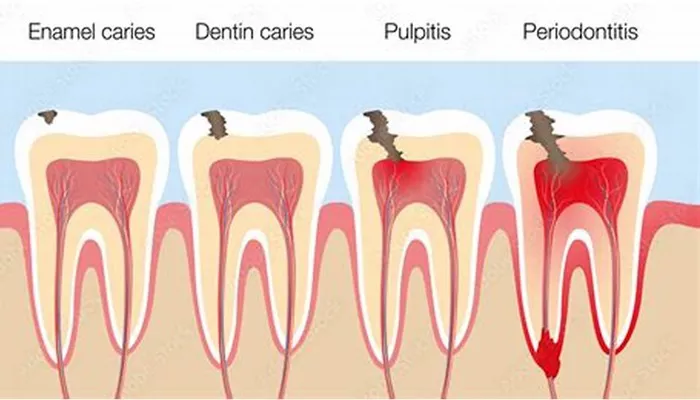Tooth enamel is the hard, outer layer of a tooth that serves as a protective barrier against decay and damage. It is the hardest substance in the human body, even more durable than bone. However, despite its strength, enamel can be compromised by various factors, leading to tooth decay. Tooth decay is a progressive disease that can result in significant damage to teeth if not addressed promptly. This article will explore what happens to tooth enamel during the process of tooth decay, detailing its stages, causes, consequences, and preventive measures.
What Is Tooth Decay?
Tooth decay, also known as dental caries or cavities, occurs when acids produced by bacteria in the mouth erode the enamel.
This process begins with the formation of plaque, a sticky film of bacteria that forms on teeth after eating. When carbohydrates from food are consumed, particularly sugars and starches, bacteria metabolize these substances and produce acids. These acids can demineralize the enamel, leading to its breakdown over time.
The Stages of Tooth Decay
Tooth decay progresses through several stages, each characterized by specific changes to the enamel and underlying tooth structure. Understanding these stages is crucial for recognizing early signs of decay and taking appropriate action.
Stage 1: Demineralization
The first stage of tooth decay is demineralization. This occurs when acids produced by plaque bacteria begin to dissolve the minerals in the enamel. Initially, this process may not cause any noticeable symptoms. However, it can lead to the appearance of white spots on the surface of the teeth, indicating mineral loss. At this stage, the damage is often reversible with proper oral hygiene practices and fluoride treatments.
Key Points:
White spots appear due to mineral loss.
Damage can be reversed with fluoride.
Good oral hygiene is essential.
Stage 2: Enamel Decay
If demineralization is not addressed, it progresses to enamel decay.
During this stage, the enamel continues to break down beneath its surface. The white spots may darken as more minerals are lost, leading to visible cavities or holes in the enamel. At this point, remineralization becomes increasingly difficult, and professional dental intervention is typically required.
Key Points:
Cavities may form as enamel continues to break down.
Darkening of previously white spots occurs.
Dental fillings are often needed at this stage.
Stage 3: Dentin Decay
Once the decay reaches the dentin—the softer layer beneath the enamel—the situation worsens significantly. Dentin is less resistant to acid than enamel and contains nerve endings that can cause pain when exposed to stimuli like temperature changes or sweet foods.
Symptoms such as increased sensitivity and pain become more pronounced as cavities deepen into this layer.
Key Points:
Dentin decay leads to increased sensitivity.
Pain may become noticeable.
Immediate dental treatment is necessary.
Stage 4: Pulp Involvement
If tooth decay continues unchecked, it can reach the pulp—the innermost part of the tooth containing nerves and blood vessels.
Infection at this stage can lead to pulpitis, characterized by severe pain and swelling due to inflammation from bacterial invasion. Treatment often involves root canal therapy to remove infected tissue and alleviate pain.
Key Points:
Infection spreads to the pulp.
Severe pain and swelling occur.
Root canal treatment may be required.
Stage 5: Abscess Formation
The final stage of untreated tooth decay is abscess formation. An abscess occurs when infection spreads beyond the tooth root into surrounding tissues, leading to pus accumulation. This condition can cause significant pain and swelling in the gums and jaw area and may require surgical intervention or extraction of the affected tooth.
Key Points:
Abscess formation indicates severe infection.
Significant pain and swelling are present.
Surgical intervention or extraction may be necessary.
Causes of Tooth Decay
Several factors contribute to tooth decay:
Poor Oral Hygiene: Inadequate brushing and flossing allow plaque buildup on teeth.
Diet: Frequent consumption of sugary or acidic foods increases acid production in the mouth.
Dry Mouth: Saliva helps neutralize acids; reduced saliva flow increases decay risk.
Fluoride Deficiency: Fluoride helps remineralize enamel; lack thereof can lead to increased susceptibility.
Medical Conditions: Certain health issues can affect oral health and increase decay risk.
Consequences of Untreated Tooth Decay
Failing to treat tooth decay can lead to serious consequences:
Pain: Advanced decay often results in severe toothaches.
Infection: Bacterial infections can spread beyond teeth into surrounding tissues.
Tooth Loss: Severe decay may necessitate extraction if a tooth cannot be saved.
Systemic Health Issues: Oral infections have been linked to other health problems like heart disease.
Preventing Tooth Decay
Preventive measures are essential for maintaining healthy enamel and preventing tooth decay:
Regular Dental Visits: Routine check-ups allow for early detection and treatment of potential issues.
Good Oral Hygiene Practices: Brushing twice daily with fluoride toothpaste and flossing regularly help remove plaque.
Balanced Diet: Limiting sugary snacks and drinks reduces acid exposure on teeth.
Fluoride Treatments: Professional fluoride applications can strengthen enamel.
Sealants: Dental sealants provide an additional protective layer over molars.
Conclusion
Tooth enamel plays a vital role in oral health by protecting teeth from decay and damage. However, it is susceptible to erosion from acids produced by bacteria in plaque. Understanding the stages of tooth decay—from initial demineralization through abscess formation—highlights the importance of early intervention and preventive care. By maintaining good oral hygiene practices, seeking regular dental care, and making informed dietary choices, individuals can protect their enamel from decay and preserve their overall oral health.
In summary, while tooth decay is a common dental issue, it is largely preventable with proper care and attention.
Recognizing early signs of enamel damage allows for timely treatment that can save teeth from severe consequences such as pain, infection, or loss.
Related topics:

